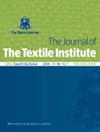多元醇对脂肪酶热稳定性的影响及其在棉织物酶处理中的应用
IF 1.5
4区 工程技术
Q2 MATERIALS SCIENCE, TEXTILES
引用次数: 2
摘要
本文研究了多元醇对脂肪酶热稳定性的影响。在75°C下加热不同时间的脂肪酶,含或不含多元醇。添加d-山梨石、d-果糖、甘露糖和麦芽糖后,脂肪酶在75℃时的半衰期(t1/2, min)分别从8.74延长到12.62、11.66、9.45和8.95。采用荧光光谱法和紫外光谱法研究了热处理后脂肪酶的构象变化。紫外光谱计算的紫外值(即脂肪酶的展开比)与失活脂肪酶的比例有关。残留活性yuv(来源于UV值)准确反映了实验数据中脂肪酶的残留活性。与75℃粗脂肪酶处理的棉织物相比,多元醇的出现在一定程度上增强了棉织物的毛细效果和减重效果。本文章由计算机程序翻译,如有差异,请以英文原文为准。
Polyols’ effect on thermal stability of lipase and its application in cotton fabrics’ enzymatic treatment
In this paper, the effect of polyols on thermal stability of lipase was investigated. Lipase, with or without polyols was heated at 75°C for different periods of time. Half-life (t1/2, min) of lipase at 75°C was prolonged from 8.74 to 12.62, 11.66, 9.45, and 8.95 with the addition of d-sorbierite, d-fructose, mannite, and maltose, respectively. Conformational changes of lipase after the heat treatment were studied by both Fluorescence spectra test and UV spectra test. The UV values (as the unfolding ratios of lipase) calculated from UV spectra were related to the proportion of inactivated lipase. Residual activityUV (originated from UV values) reflected residual lipase activity from the experimental data accurately. Compared with cotton fabrics treated by the crude lipase at 75°C, the appearance of polyols enhanced the capillary effect and weight loss of cotton fabrics to some extent.
求助全文
通过发布文献求助,成功后即可免费获取论文全文。
去求助
来源期刊

Journal of the Textile Institute
工程技术-材料科学:纺织
CiteScore
4.20
自引率
5.90%
发文量
149
审稿时长
1.0 months
期刊介绍:
The Journal of The Textile Institute welcomes papers concerning research and innovation, reflecting the professional interests of the Textile Institute in science, engineering, economics, management and design related to the textile industry and the use of fibres in consumer and engineering applications. Papers may encompass anything in the range of textile activities, from fibre production through textile processes and machines, to the design, marketing and use of products. Papers may also report fundamental theoretical or experimental investigations, including materials science topics in nanotechnology and smart materials, practical or commercial industrial studies and may relate to technical, economic, aesthetic, social or historical aspects of textiles and the textile industry.
All published research articles in The Journal of The Textile Institute have undergone rigorous peer review, based on initial editor screening and anonymized refereeing by two expert referees.
 求助内容:
求助内容: 应助结果提醒方式:
应助结果提醒方式:


